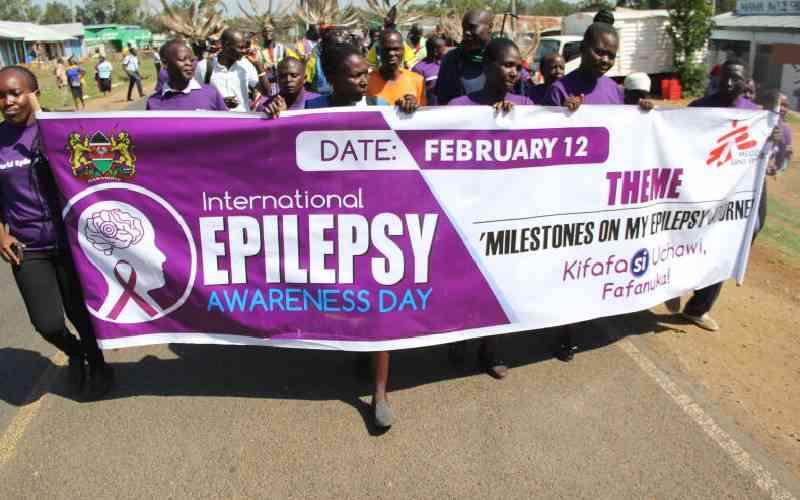
Residents during celebrations to mark World Epilepsy Day, at Marindi Sub-county Hospital in Homa Bay County, on February 12, 2025. [File, Standard]
For many communities, epilepsy is still wrongly believed to be the result of curses, witchcraft or demonic possession. Such myths, health experts warn, continue to fuel stigma and prevent people from seeking the treatment they urgently need.
Nicholas Otieno, a clinical officer with the Kenya Association for the Welfare of People with Epilepsy (Kawe), says these misconceptions stop patients from visiting hospitals and health centres.
“These myths are the reasons why people do not come to health facilities. The first thing we explain is that epilepsy is a medical condition, not a curse. That is why we conduct community-level awareness campaigns to break down these barriers,” Otieno said.
To address the problem, Kawe runs an “epilepsy cascade target” programme which aims to ensure that 90 per cent of people with epilepsy understand their diagnosis as a treatable brain disorder. The organisation uses “stigma benches” where community members openly discuss myths and misconceptions. Chiefs and health promoters are also trained and given materials to spread awareness more widely.
“Epilepsy can manifest with convulsions, brief stares, muscle spasms, odd sensations or smells, or episodes of automatic behaviour and altered awareness. The type of seizure depends on the part of the brain affected, and it can occur at any age—from infancy to old age,” he added.
According to the World Health Organization (WHO), epilepsy is a chronic non-communicable disease of the brain that affects around 50 million people worldwide. It is characterised by recurrent seizures, which may involve part of the body (partial) or the entire body (generalised), and are sometimes accompanied by loss of consciousness and loss of bladder or bowel control.
- Trump pulls US from World Health pandemic reforms
- Suicide behind one in every 100 deaths: WHO
- Global warming linked to consumption of sugary drinks, ice cream
- Progress slowing 'significantly' against non-communicable diseases, WHO warns
Keep Reading
Seizures arise from excessive electrical discharges in brain cells. They can range from brief lapses in attention or muscle jerks to severe and prolonged convulsions. Frequency also varies greatly—from fewer than one a year to several a day. Importantly, one seizure alone does not mean epilepsy; the condition is diagnosed when two or more unprovoked seizures occur.
Epilepsy is among the world’s oldest recognised medical conditions, with written records dating back to 4000 BC. Yet fear, misunderstanding and stigma have surrounded it for centuries. This prejudice still persists in many countries, reducing the quality of life for those affected and their families.
Medical experts classify epilepsy according to cause. Symptomatic epilepsy is linked to identifiable brain pathology. Cryptogenic epilepsy arises when a cause is suspected but not proven. Idiopathic epilepsy has no established cause but is believed to have a genetic basis.
Seizures differ according to where in the brain the disturbance starts and how far it spreads. Symptoms may include loss of awareness or consciousness, disturbances in movement, changes in vision, hearing or taste, and shifts in mood or cognition.
Beyond seizures, people with epilepsy often face injuries such as fractures and bruising, as well as higher rates of anxiety and depression. Their risk of premature death is up to three times higher than in the general population, particularly in low- and middle-income countries. Many deaths, however, are preventable, such as those caused by drowning, burns, falls or prolonged seizures.
The disease is not contagious, though many mechanisms can cause it. In half of cases, the cause remains unknown. Known causes include birth complications, congenital abnormalities, head injury, stroke, brain infections such as meningitis, encephalitis or neurocysticercosis, genetic syndromes and brain tumours.
Despite the challenges, epilepsy is highly treatable. Up to 70 per cent of patients could live seizure-free with proper use of antiseizure medicines. Patients who remain seizure-free for two years may, under medical guidance, stop medication. Surgery is also an option for those who do not respond to drugs.
The biggest barrier remains access. In many low-income countries, three-quarters of patients receive no treatment, largely due to low availability of antiseizure medicines. Studies show that in such countries, the average availability of generic drugs in public health systems is below 50 per cent. Yet most epilepsy can be managed at the primary health-care level, without advanced equipment.
Prevention also matters. WHO estimates that a quarter of cases could be avoided through measures such as improving perinatal care, controlling fevers in children, reducing head injuries and managing cardiovascular risks to prevent strokes.
 The Standard Group Plc is a multi-media organization with investments in media
platforms spanning newspaper print
operations, television, radio broadcasting, digital and online services. The
Standard Group is recognized as a
leading multi-media house in Kenya with a key influence in matters of national
and international interest.
The Standard Group Plc is a multi-media organization with investments in media
platforms spanning newspaper print
operations, television, radio broadcasting, digital and online services. The
Standard Group is recognized as a
leading multi-media house in Kenya with a key influence in matters of national
and international interest.











